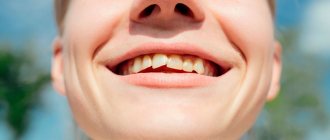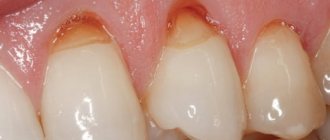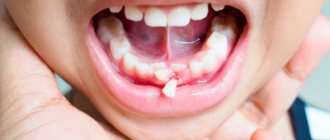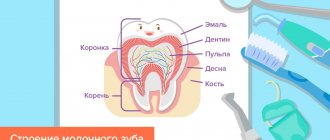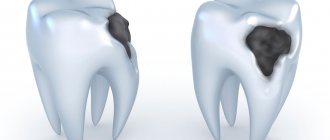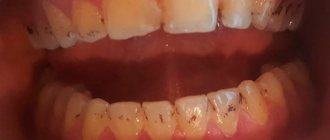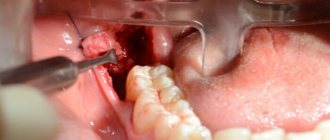Braces
If a child’s permanent teeth grow unevenly and grow crooked after the complete disappearance of milk teeth (usually at the age of 12-14 years), the most effective method will be to use braces. However, parents should understand that a massive accessory is not attractive enough, so the little patient will be embarrassed to wear it at first. In addition, not everyone wants to endure physical discomfort. The main task of the family is to convince the teenager of the need for intervention.
Useful tips:
- colored, ceramic and sapphire devices are aesthetically attractive and will help create a unique image;
- It is better to install braces during the holidays, since during the adaptation period children experience discomfort due to rubbing of the mucous membranes, pain, and speech impairments;
- After installation, there is no need to plan long trips, because every 1-1.5 months it is worth visiting the orthodontist to reconfigure the pressure force of the system on the crowns.
Orthognathic surgery
What to do when a child has uneven baby teeth, all of the above methods have not shown positive results, and the existing skeletal abnormalities affect not only the appearance, but also the quality of life? In this case, surgical intervention is indicated. However, most doctors note that surgical manipulations are contraindicated if the jaws have not yet formed, which means it is better not to carry out the procedure until the baby is older.
After the operation, a long recovery period (about a month) is required. Subsequently, treatment continues with the use of braces, plates or trainers.
Crooked baby teeth
Baby teeth serve a child for only 6–8 years, so their position does not always require correction, however, the state of the baby occlusion can be used to judge how correct the eruption of permanent teeth will be.
Gaps between baby teeth are normal, but rotation and crowding are no longer the case.
Rotation of baby teeth
The same applies to the bite: it should not be asymmetrical or open, the lower teeth should not completely overlap the upper ones. In such a situation, you need to consult an orthodontist.
The doctor may determine:
- Why did the disorder occur at such an early age? Are bad habits to blame (for example, feeding from a bottle at an age when a child should already eat with a spoon), poor posture, some congenital characteristics, etc.
- How can this be corrected? Refer the child to an orthopedist for additional examination or simply advise parents on how to organize nutrition.
- When should you be examined again? Follow-up in orthodontics is very important; appointments are usually recommended every 6–12 months. Then you can see in dynamics how the condition of the teeth changes.
Therefore, there are contraindications to orthodontics:
- blood diseases;
- tuberculosis;
- HIV;
- diabetes;
- immune system diseases;
- some forms of osteopathy, osteoporosis;
- most mental illnesses;
- poorly compensated diseases of internal organs.
Interventions in the oral cavity should not be performed if there is bleeding or poor wound healing. The patient may harm himself with the orthodontic device, or it will hinder the actions of resuscitators in the event of decompensation of a chronic disease.
Important: The doctor’s duty is to primarily pay attention to vital organs and take into account the potential risks of orthodontic operations. Patients should be understanding about prohibitions and not insist on interventions that are dangerous to life and health.
Treatment of children
Children have fewer aesthetic requirements, but the ability to quickly remove orthodontic appliances is important. Taking this into account, removable plates are usually used. In large cities where dental care is developed, almost everyone has seen elementary school students with “braces” in their mouths. Devices sparkling with chrome and nickel are attractive in their own way, and are even perceived by schoolchildren as decoration. Not everyone's parents allow them to wear earrings or get piercings, but a dentist can legally put a nice toy on your teeth.
Records have many useful functions. In addition to correcting the position of the teeth, they normalize the functioning of the jaw muscles and promote the proper development of bones. The tongue and cheeks stop putting pressure on the crowns.
Unfortunately, treatment with plates is only available up to a certain age - 10-12 years. Then all the baby teeth fall out, and there are many permanent teeth in front. Other correction methods are needed.
Important: Orthodontic treatment of patients under 18 years of age requires the written consent of their guardian adults.
Treatment for adults
The most effective and popular method of correcting uneven teeth in adults is braces. But there is an alternative: transparent removable aligners or prosthetics.
Prosthetics show good results when there are wide gaps between all front teeth. In this case, no matter how you correct the position of the crowns, your smile will not become more beautiful. But dental onlays made of durable ceramics matched to the color (veneers, lumineers) expand natural teeth. The crowns are ground down and you need to wear dentures for life. Their average service life is several years. The patient should keep this in mind when contacting the dentist.
Restoration with specific composite materials also helps. It is better to resort to it if there are carious cavities and other shape defects in the crowns. Composites require regular polishing, but in some cases they are the best choice (deep caries on the incisors).
Transparent aligners (aligners) are made from polymers with the optimal combination of rigidity and ductility for this purpose. They are put on several adjacent teeth, often on all the front teeth at once. Aligners are worn almost 24 hours a day, being removed for eating and brushing teeth.
Advantages of mouth guards:
- easy to remove;
- invisible from the outside;
- safe for children;
- a person quickly gets used to them;
- diction is maintained;
- mucous membranes are not injured;
- tooth enamel is not damaged.
Disadvantages of aligners:
- suitable only for the simplest dental defects;
- Only a highly qualified dentist can make mouth guards.
Mouthguards exert little pressure on the teeth and cannot correct defects such as rotation of the crown around its axis. But in simple cases, patients find it more pleasant to wear them than braces.
Ribbed teeth
Why do ribbed or “wavy” teeth grow? This is the norm. The front surface of the teeth should be even and smooth. But the cutting edge of permanent teeth is ribbed when they erupt. This is especially noticeable on the incisors.
Wavy edges of newly erupted teeth
On the cutting edge of the teeth, the thickness of the enamel is greater than on the front or side surfaces. It is quite enough for the teeth to wear down a little naturally during chewing. Therefore, soon the lower edges of the teeth will become smooth.
But this will only work if the teeth are closed correctly, that is, there is adequate load on the cutting edges. If the teeth are crowded or tilted to the sides, the lower (ribbed) part will not grind down and the visual defect will remain. At least until the bite is corrected.
Symptoms
The diagnosis of “uneven teeth” includes many different defects. They can hardly be called diseases; rather, they are cosmetic problems. Only in rare cases is there a serious impairment of chewing function. Usually the teeth “grind” against each other, and contact is established between them, sufficient for confident chewing.
There may be violations:
- location of teeth;
- growth directions;
- tooth sizes;
- dental crown shapes.
Humans are mammals, and their teeth are very different. But for each tooth there is a fairly accurate version of the norm, and small deviations make the dentition unsightly. Large or small teeth, protruding forward or backward, displaced to the side, not corresponding to their intended purpose (incisors, canines, molars) - patients turn to the orthodontist with such a wide range of defects.
Normally, crowns fit tightly to adjacent ones, or the gaps are minimal. Expanded ones, which are popularly called “birdhouse”, look unimportant and can cause damage to the gums when chewing.
The symptoms of malocclusion are usually obvious; an experienced orthodontist does not require additional research to clarify the diagnosis. In some cases, radiography is useful. Teeth (usually fangs) can shift due to the growth of excess teeth nearby, which normally should not be there. On an x-ray, the location and angle of inclination of the roots of teeth “number 1” and “number 2” are determined, and how healthy they are is assessed. Then they decide to keep or delete some of them.
Yellow teeth in a child
Yellowing of enamel is not always a consequence of bad habits. Sometimes it occurs in children too.
If the enamel is uniformly yellowish, this is a congenital feature that does not in any way affect the strength of the teeth. If the yellowing is not uniform, but spotty, the spots are more dull than the rest of the enamel surface, this is fluorosis. With it, the spots can be white, but they will still stand out due to their matte surface. Specks appear due to the increased fluoride content in drinking water.
Yellow spots on baby teeth
Yellowing of enamel in children cannot be corrected. All aesthetic procedures are carried out with permanent teeth.
Prevention
It is much easier, as dentists note, to initially help teeth grow correctly than to later correct the growth of crooked chewing teeth. Prevention is recommended from early childhood. Need to:
- initially correctly approach the process of organizing nutrition (women are advised to think about this even during pregnancy) in order to supply the growing body with a sufficient amount of calcium;
- as early as possible, wean your baby off pacifiers, bottles, thumb sucking and other habits that can negatively affect tooth growth;
- promptly identify and treat pathologies of the ENT organs in order to prevent the baby from developing the habit of breathing through the mouth instead of the nose;
- From childhood, accustom your child to the need to carefully care for their teeth, regularly visit the dentist for preventive examinations and treatment if necessary.
It is important to remember that keeping a small child on pureed food for a long time is harmful. It is necessary to switch to solid foods as soon as possible. Consumption of, for example, hard apples or carrots has a positive effect on the formation of the jaw and promotes the proper development of bone tissue. A common mistake that leads to malocclusion in the future is precisely keeping children on a diet of exclusively pureed food for a long time.
Teeth are organs that need attention from childhood. This way you can avoid not only oral diseases, but also get a beautiful smile that attracts people's gaze!
Author: Zhukov M.A.
Incorrect occlusion
Is it possible to judge from the malocclusion of baby teeth what the permanent bite will be like? To some extent, yes, since the reasons for the formation of incorrect occlusion do not depend on whether they are permanent or baby teeth.
Examples:
Open bite: the teeth do not close together, the chewing process is already disrupted
Straight bite: teeth close together at the edges, decay faster, and may fall out prematurely
Regular monitoring by a pediatric dentist and, if necessary, an orthodontist is the key to ensuring that serious problems are detected in a timely manner. It is recommended to start correcting the bite as soon as all the permanent teeth have finished erupting - then the treatment is easiest to carry out.
Other articles:
5 reasons to cure caries on a baby tooth without delay
How to help your child not be afraid of dentists
If a child does not want to be treated by an orthodontist...
Content:
- A competent approach to the problem
- If the very first teeth are crooked
- Causes of crooked teeth
- What to do if a tooth grows crookedly
- Do I need to straighten crooked teeth?
Seeing that a canine or incisor is “looking in the wrong direction,” parents immediately ask the question whether baby teeth can grow crooked. Knowing the correct answer to this is very important, because failure to take therapeutic measures in a timely manner can result in an unaesthetic smile in adulthood.
What could be the consequences?
It is impossible to ignore an incorrect bite: the consequences turn out to be much deeper than just crooked teeth in the photo and inconvenience when chewing. Crooked teeth are difficult to clean, so bacteria accumulate among them, causing chronic inflammation. It can spread to the mucous membrane and even to the bone. Another disease of this kind is chronic stomatitis. It appears due to the fact that the tooth constantly damages the mucous membrane in one place.
An incorrect bite leads to poor digestion of food, which can lead to gastritis or even an ulcer. This is also facilitated by the entry of bacteria into the intestinal tract. Along with gastrointestinal diseases, skin diseases appear, hair becomes more brittle, and other organs that do not receive sufficient nutrition also suffer.
The uneven position of teeth also provokes premature aging of the facial skin and the appearance of deep expression wrinkles. And too much stress on the masticatory muscle is transferred to the joint, which quickly wears out, begins to click, crunch, and then hurt. Unpleasant sensations almost always go to your head, causing something like a migraine.
Braces
Braces are elegant overlays on teeth that connect several adjacent crowns. Unlike more massive and removable brackets, which close only at the edges, the thin wires of braces connect at each interdental space. It is not the wire that presses on the tooth, but a flat pad made of metal, stone or ceramics, or plastic. Injury to the enamel is minimized, and no cavity is formed on the tooth.
According to the method of fastening, there are ligature braces, they are fixed with a lock on the orthodontic arch (elastic ring), and non-ligature braces, with a groove that closes with a latch.
There are many types of braces. Some play a purely decorative role without correcting the position of the teeth. Such jewelry can be seen on famous people who love extravagance, they have even become fashionable in recent years. The most expensive ones are sapphire braces, with artificial semi-precious stones. They are beautiful, but may be too hard for enamel. Ceramics (porcelain) is good because it can easily match the natural color of the enamel. Plastic ones are the most economical, but they need to be replaced more often, possibly staining the plastic with food and drinks.
Dentists recommend more practical and safe designs made entirely of metal. Manufacturing parts from the same alloy eliminates the formation of electrochemical stresses in a liquid medium. The metal does not corrode in saliva, and the treatment proceeds optimally. If metal crowns are already installed on your teeth, it is better to choose a similar alloy for braces. Expensive decorative items are made from gold. Biologically compatible titanium and “stainless” nickel are used.
More often, braces (onlays) are placed on the outside of the teeth, adjacent to the lips and cheeks. But they also make lingual braces that face the inside of the mouth. Placement near the tongue impairs the pronunciation of sounds and interferes with eating, so this option is rarely used. An indication may be the presence of injuries to the mucous membrane of the cheeks, the occurrence of tumors on them in the past. If any tumor is present, even benign, this is a clear contraindication to installing braces. The main advantage of lingual braces is their invisibility. Only a narrow strip of metal is visible on the outside of the teeth.
How long do you wear braces? As a rule, from one and a half to three years. The patient should prepare for long-term treatment. It is better to treat braces as decoration and find aesthetic meaning in wearing them. Then there will be no psychological discomfort.
It is clear that it is more pleasant to wear objectively beautiful braces. If funds allow or appearance is very important to the patient, you can order braces that are no worse than jewelry. Sapphires are just one of the possible design options.
The first signs of bite improvement appear 3-4 months after the installation of braces. But they cannot be removed, the teeth are still unstable in the new position and will easily return to their previous incorrect position. The patient is regularly seen by the dentist; constant supervision of a specialist over the condition of the dentition is necessary.
Don’t worry, the doctor will not “overexpose” the braces on your teeth unnecessarily. If the patient himself wishes to wear them in the future as decoration, others are made that do not exert noticeable pressure on the teeth.
Installing braces takes about one and a half hours. The teeth are professionally cleaned, washed, dried, treated with antiseptics, washed and dried again. Then a primer and adhesive are applied - glue to fix the overlays. The braces are fixed, excess glue is removed and it is polymerized with powerful light radiation.
When wearing braces, special oral care is required. A special brush is used to clean teeth. Clean thoroughly, but carefully, after each meal. You will have to exclude hard foods from your diet: nuts, hard vegetables and fruits. Carrots or apples can be grated or ground in a blender. It is better to consume less hot and cold, as well as sweets, which cause increased growth of bacteria in the mouth. Temperature changes cause crowns to contract and expand. Germs can cause tooth decay, and braces will have to be removed prematurely to treat it.
How to prevent pathology
prevent your child from developing crooked teeth by regularly visiting the orthodontist's office. Even if your baby has a genetic predisposition to certain diseases, dealing with them at an early stage is much easier.
Adults can avoid the appearance of upper and lower crooked teeth if they do not delay the installation of implants after the loss of one of the molars, and also remove their wisdom teeth in a timely manner. In addition, it is necessary to get rid of the habit of gnawing on durable objects, not to knock your teeth against each other and not to clench your jaw during emotional stress.
